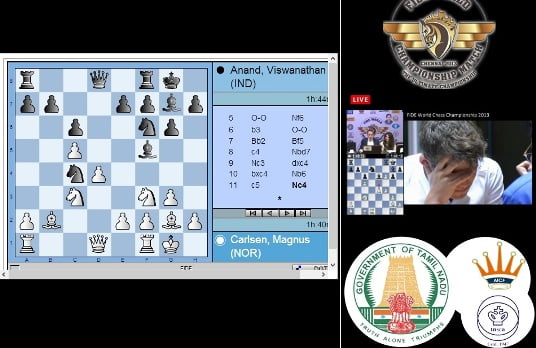
The World Chess Championship has started, and I am glued to my screen. Along with millions of others, I am able to follow the contest between India’s Vishy Anand (the current world champion) and Norway’s Magnus Carlsen through a bewildering variety of options, as the internet connects up all of us across the globe to the mental activity of two men in Chennai, India, seated facing each other across a board with sixty-four squares and thirty-two pieces. What takes place in the brain of the two leading exponents of the world’s finest game radiates outwards across the globe, replayed on screens and boards, analysed by programmes, commented upon, tweeted. It is the perfect exemplification of our interconnected world.
The content is taking place over 12 games, between 9 and 28 November, with blitz tie-break games to be played on the 28th is all is square by the 26th. I have been watching via the official site, which provides three views – video of the game itself, video of two commentators with a chessboard on which they play out possible variations, and a board documenting the moves of the game itself. The experience of watching and listening is a little odd, because there is a time lag between electronic board and video (which the commentators are following), so one sees what has been played on the board, then a minute later sees the documented on the would-be live video stream, and then the commentary coming in third.

This is just one site among many which is following the game. Alternative include Chess.com’s live TV stream, 2700chess.com, the official YouTube channel and Chessdom. There’s also a handy Twitter guide to the world chess championship.
Given all the hype and the technology, it has been a tad disappointing that the first two games were both quick draws by repetitions, the players early on reaching situations where they would rather repeat sequences than risk a disadvantage – when both players play the same moves three times, a draw is automatically declared. Much more of this and the joined-up world is going to be mightily disappointed, but the age of romantic chess, with its sacrifices, surprises and innovations is long over. That sort of play now exists only in blitz chess, where all the moves must be made in something like five minutes and errors are inevitable. Here instead we have two minds almost cancelling one another out, practically before the games has begun. Chess followers are familiar with grandmaster draws where players follow familiar lines and end up at some point in the middle game where neither can see an advantage to be had and so agree a draw. But will we eventually get to a point where every opening strategy is so well known – and the pitfalls over steering clear of such strategies so obvious – that someone will play e4 for their opening move and a draw is immediately declared? Will chess have then come to an end?
Hopefully not just yet, and hopefully the full contest will prove worthy of its billing. I’m not much bothered about who will win. I want the game to win.